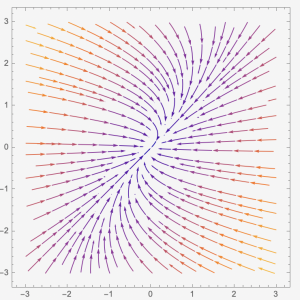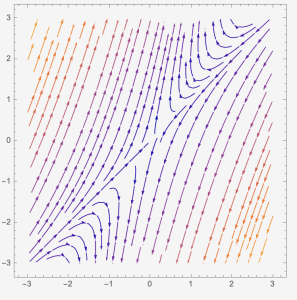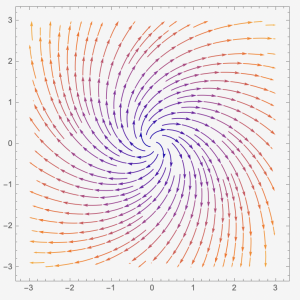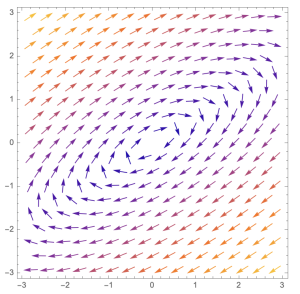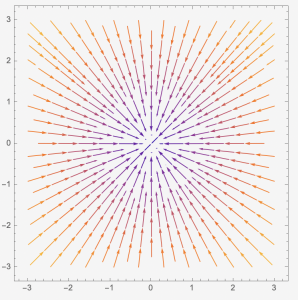Section 5.7. Classify Phase planes
Objective:
Classify Phase planes with eigenvalues
In this section, we are going to summarize all cases that we considered and classify all phase planes. Recall that a given matrix [latex]A[/latex] and a system of homogeneous differential equation [latex]\overrightarrow{X}=A\overrightarrow{x}[/latex], we can find the eigenvalues of the matrix [latex]A[/latex] and then eigenvectors. [latex]\text{det}(A-\lambda I)=0=f(\lambda),[/latex] the characteristics equation determinate the eigenvalues.
Case 1: When [latex]f(\lambda)=0[/latex] has two distinct positive real solutions, [latex]\lambda_{1} \gt \lambda_{2} \gt 0[/latex]. In this case, we have two eigenvectors, [latex]\overrightarrow{v_{1}}[/latex] and [latex]\overrightarrow{v_{2}}[/latex]. The entries of [latex]\overrightarrow{v_{1}}[/latex] and [latex]\overrightarrow{v_{2}}[/latex] are real numbers. The general solution will be [latex]\overrightarrow{x(t)}=c_{1}e^{\lambda_{1}t}\overrightarrow{v_{1}}+c_{2}e^{\lambda_{2}t}\overrightarrow{v_{2}}[/latex]. The phase plane has two straight lines such that they present the eigenvector directions. The arrows are pointing away from the [latex](0,0)[/latex]. The [latex]\overrightarrow{x}=\overrightarrow{0}[/latex] is called a nodal source and is an unstable solution.
Case 2: When [latex]f(\lambda)=0[/latex] has two distinct negative real solutions, [latex]\lambda_{1} \lt \lambda_{2} \lt 0[/latex]. }In this case, we have two eigenvectors, [latex]\overrightarrow{v_{1}}[/latex] and [latex]\overrightarrow{v_{2}}[/latex]. The entries of [latex]\overrightarrow{v_{1}}[/latex] and [latex]\overrightarrow{v_{2}}[/latex] are real numbers. The general solution will be [latex]\overrightarrow{x(t)}=c_{1}e^{\lambda_{1}t}\overrightarrow{v_{1}}+c_{2}e^{\lambda_{2}t}\overrightarrow{v_{2}}[/latex]. The phase plane has two straight lines such that they present the eigenvector directions. The arrows are pointing toward the [latex](0,0)[/latex]. The [latex]\overrightarrow{x}=\overrightarrow{0}[/latex] is called a nodal sink and is a stable solution.
Case 3: When [latex]f(\lambda)=0[/latex] has two distinct real solutions, one is positive and one is negative, [latex]\lambda_{1} \lt 0 \lt \lambda_{2}[/latex]}. In this case, we have two eigenvectors, [latex]\overrightarrow{v_{1}}[/latex] and [latex]\overrightarrow{v_{2}}[/latex]. The entries of [latex]\overrightarrow{v_{1}}[/latex] and [latex]\overrightarrow{v_{2}}[/latex] are real numbers. The general solution will be [latex]\overrightarrow{x(t)}=c_{1}e^{\lambda_{1}t}\overrightarrow{v_{1}}+c_{2}e^{\lambda_{2}t}\overrightarrow{v_{2}}[/latex]. The phase plane has two straight lines such that they present the eigenvector directions. The arrow on [latex]\overrightarrow{v_{1}}[/latex] is pointing toward the [latex](0,0)[/latex], and the arrow on [latex]\overrightarrow{v_{2}}[/latex] is pointing away from [latex](0,0)[/latex]. The [latex]\overrightarrow{x}=\overrightarrow{0}[/latex] is called a saddle point and is an unstable solution.
Example 1: Given [latex]\left[\begin{array}{c} x_{1}'\\ x_{2}' \end{array}\right]=\left[\begin{array}{cc} -4 & -4\\ 0 & -1 \end{array}\right]\left[\begin{array}{c} x_{1}\\ x_{2} \end{array}\right]=A\overrightarrow{x}[/latex], find the general solution of the system of equations. Classify the stability of the equilibrium solution [latex]\overrightarrow{x}=\overrightarrow{0}[/latex] and describe what kind of critical point it is.
Exercise 1: Given [latex]\left[\begin{array}{c} x_{1}'\\ x_{2}' \end{array}\right]=\left[\begin{array}{cc} -2 & 0\\ 3 & 1 \end{array}\right]\left[\begin{array}{c} x_{1}\\ x_{2} \end{array}\right]=A\overrightarrow{x}[/latex], find the general solution of the system of equations. Classify the stability of the equilibrium solution [latex]\overrightarrow{x}=\overrightarrow{0}[/latex] and describe what kind of critical point it is.
Case 4: When [latex]f(\lambda)=0[/latex] has two distinct complex solutions, [latex]\lambda=a\pm bi[/latex] and [latex]a\neq0[/latex]. In this case, we have two eigenvectors, [latex]\overrightarrow{v_{1}}=\overrightarrow{p}+i\overrightarrow{q}[/latex] and [latex]\overrightarrow{v_{2}}=\overrightarrow{p}-i\overrightarrow{q}[/latex]. The entries of [latex]\overrightarrow{p}[/latex] and [latex]\overrightarrow{q}[/latex] are real numbers. The general solution will be [latex]\overrightarrow{x(t)}=e^{at}(c_{1}(\text{cos}(bt)\overrightarrow{p}-\text{sin}(bt)\overrightarrow{q})+c_{2}(\text{sin}(bt)\overrightarrow{p}+\text{cos}(bt)\overrightarrow{q}))[/latex]. The entries of the vector [latex]\overrightarrow{x(t)}[/latex] have [latex]\text{cos}(bt)[/latex] and [latex]\text{sin}(bt)[/latex]. The phase plane has clock-wise spiral orientations. The arrows on are pointing toward the [latex](0,0)[/latex] if [latex]a \lt 0[/latex], and the arrows are pointing away from [latex](0,0)[/latex] if [latex]a \gt 0[/latex]. The [latex]\overrightarrow{x}=\overrightarrow{0}[/latex] is called a spiral sink and is a stable solution for [latex]a \lt 0[/latex] case, and is called a spiral source and is an unstable solution for [latex]a \gt 0[/latex] case.
Example 2: Given [latex]\left[\begin{array}{c} x_{1}'\\ x_{2}' \end{array}\right]=\left[\begin{array}{cc} -1 & 2\\ -2 & -1 \end{array}\right]\left[\begin{array}{c} x_{1}\\ x_{2} \end{array}\right]=A\overrightarrow{x}[/latex], find the general solution of the system of equations. Classify the stability of the equilibrium solution [latex]\overrightarrow{x}=\overrightarrow{0}[/latex] and describe what kind of critical point it is.
Exercise 2: Given [latex]\left[\begin{array}{c} x_{1}'\\ x_{2}' \end{array}\right]=\left[\begin{array}{cc} 2 & -3\\ 3 & 2 \end{array}\right]\left[\begin{array}{c} x_{1}\\ x_{2} \end{array}\right]=A\overrightarrow{x}[/latex], find the general solution of the system of equations. Classify the stability of the equilibrium solution [latex]\overrightarrow{x}=\overrightarrow{0}[/latex] and describe what kind of critical point it is.
Case 5: When [latex]f(\lambda)=0[/latex] has two distinct complex solutions, [latex]\lambda=\pm bi[/latex].} In this case, we have two eigenvectors, [latex]\overrightarrow{v_{1}}=\overrightarrow{p}+i\overrightarrow{q}[/latex] and [latex]\overrightarrow{v_{2}}=\overrightarrow{p}-i\overrightarrow{q}[/latex]. The general solution will be [latex]\overrightarrow{x(t)}=(c_{1}(\text{cos}(bt)\overrightarrow{p}-\text{sin}(bt)\overrightarrow{q})+c_{2}(\text{sin}(bt)\overrightarrow{p}+\text{cos}(bt)\overrightarrow{q}))[/latex]. The entries of the vector [latex]\overrightarrow{x(t)}[/latex] have [latex]\text{cos}(bt)[/latex] and [latex]\text{sin}(bt)[/latex]. The phase plane has counter-clock-wise or clock-wise circular ( ellipse) orientations. The arrows counter-clock-wise or counter-clock-wise. The [latex]\overrightarrow{x}=\overrightarrow{0}[/latex] is called center and is a (neutrally) stable solution.
Example 3: Given [latex]\left[\begin{array}{c} x_{1}'\\ x_{2}' \end{array}\right]=\left[\begin{array}{cc} 2 & -4\\ 2 & -2 \end{array}\right]\left[\begin{array}{c} x_{1}\\ x_{2} \end{array}\right]=A\overrightarrow{x}[/latex], find the general solution of the system of equations. Classify the stability of the equilibrium solution [latex]\overrightarrow{x}=\overrightarrow{0}[/latex] and describe what kind of critical point it is.
Exercise 3: Given [latex]\left[\begin{array}{c} x_{1}'\\ x_{2}' \end{array}\right]=\left[\begin{array}{cc} -3 & -5\\ 2 & 3 \end{array}\right]\left[\begin{array}{c} x_{1}\\ x_{2} \end{array}\right]=A\overrightarrow{x}[/latex], find the general solution of the system of equations. Classify the stability of the equilibrium solution [latex]\overrightarrow{x}=\overrightarrow{0}[/latex] and describe what kind of critical point it is.
Case 6: When [latex]f(\lambda)=0[/latex] has one real solution, [latex]\lambda_{1}[/latex], and two eigenvectors, [latex]\overrightarrow{v_{1}}[/latex] and [latex]\overrightarrow{v_{2}}[/latex]. }The entries of [latex]\overrightarrow{v_{1}}[/latex] and [latex]\overrightarrow{v_{2}}[/latex] are real numbers. The general solution will be [latex]\overrightarrow{x(t)}=c_{1}e^{\lambda_{1}t}\overrightarrow{v_{1}}+c_{2}e^{\lambda_{1}t}\overrightarrow{v_{2}}[/latex]. The phase plane has straight lines passing [latex](0,0)[/latex]. The arrow those lines are pointing toward the [latex](0,0)[/latex] if [latex]\lambda_{1} \lt 0[/latex], and the arrows are pointing away from [latex](0,0)[/latex] if [latex]\lambda_{1} \gt 0[/latex]. The [latex]\overrightarrow{x}=\overrightarrow{0}[/latex] is called a star node, sometimes is called proper node. It is a stable solution if [latex]\lambda_{1} \lt 0,[/latex] and an unstable solution if [latex]\lambda_{1} \gt 0[/latex].
Example 4: Given [latex]\left[\begin{array}{c} x_{1}'\\ x_{2}' \end{array}\right]=\left[\begin{array}{cc} 2 & 0\\ 0 & 2 \end{array}\right]\left[\begin{array}{c} x_{1}\\ x_{2} \end{array}\right]=A\overrightarrow{x}[/latex], find the general solution of the system of equations. Classify the stability of the equilibrium solution [latex]\overrightarrow{x}=\overrightarrow{0}[/latex] and describe what kind of critical point it is.
Exercise 4: Given [latex]\left[\begin{array}{c} x_{1}'\\ x_{2}' \end{array}\right]=\left[\begin{array}{cc} -3 & 0\\ 0 & -3 \end{array}\right]\left[\begin{array}{c} x_{1}\\ x_{2} \end{array}\right]=A\overrightarrow{x}[/latex], find the general solution of the system of equations. Classify the stability of the equilibrium solution [latex]\overrightarrow{x}=\overrightarrow{0}[/latex] and describe what kind of critical point it is.
Case 7: When [latex]f(\lambda)=0[/latex] has one real solution, [latex]\lambda_{1}[/latex], and one eigenvector, [latex]\overrightarrow{v}[/latex]. The entries of [latex]\overrightarrow{v}[/latex] are real numbers. The general solution will be [latex]\overrightarrow{x(t)}=c_{1}e^{\lambda_{1}t}\overrightarrow{v}+c_{2}[e^{\lambda_{1}t}\overrightarrow{w}+e^{\lambda_{1}t}t\overrightarrow{v}][/latex] where [latex](A-\lambda_{1})\overrightarrow{w}=\overrightarrow{v}[/latex]. The phase plane has one straight line passing [latex](0,0)[/latex]. The arrow those lines are pointing toward the [latex](0,0)[/latex] if [latex]\lambda_{1} \lt 0[/latex], and the arrows are pointing away from [latex](0,0)[/latex] if [latex]\lambda_{1} \gt 0[/latex]. The [latex]\overrightarrow{x}=\overrightarrow{0}[/latex] is called an improper node. It is a stable solution if [latex]\lambda_{1} \lt 0,[/latex] and an unstable solution if [latex]\lambda_{1} \gt 0[/latex].
Example 5: Given [latex]\left[\begin{array}{c} x_{1}'\\ x_{2}' \end{array}\right]=\left[\begin{array}{cc} 2 & 3\\ 0 & 2 \end{array}\right]\left[\begin{array}{c} x_{1}\\ x_{2} \end{array}\right]=A\overrightarrow{x}[/latex], find the general solution of the system of equations. Classify the stability of the equilibrium solution [latex]\overrightarrow{x}=\overrightarrow{0}[/latex] and describe what kind of critical point it is.
Exercise 5: Given [latex]\left[\begin{array}{c} x_{1}'\\ x_{2}' \end{array}\right]=\left[\begin{array}{cc} -3 & 0\\ 2 & -3 \end{array}\right]\left[\begin{array}{c} x_{1}\\ x_{2} \end{array}\right]=A\overrightarrow{x}[/latex], find the general solution of the system of equations. Classify the stability of the equilibrium solution [latex]\overrightarrow{x}=\overrightarrow{0}[/latex] and describe what kind of critical point it is.

